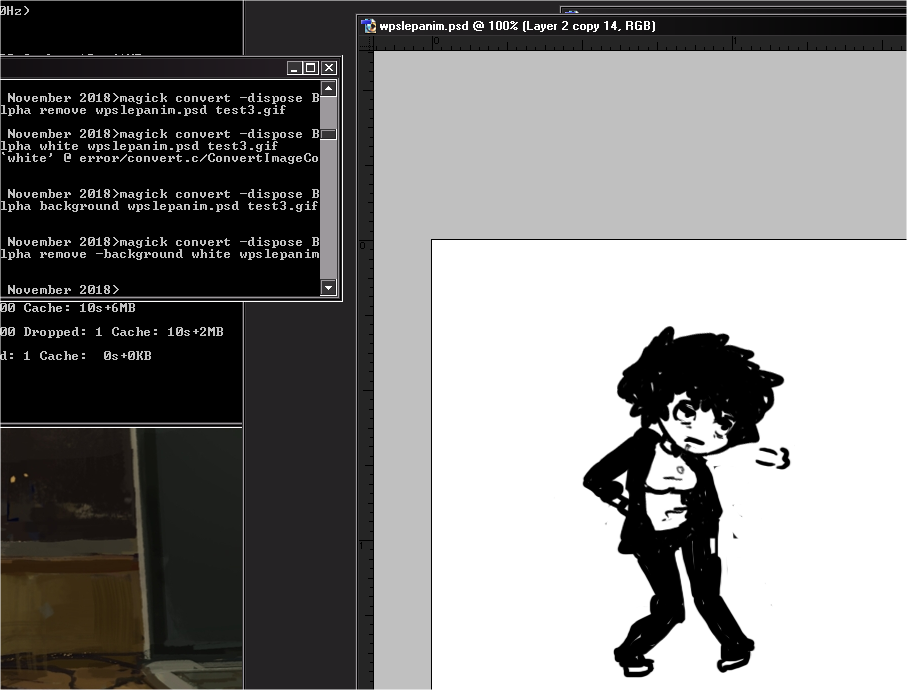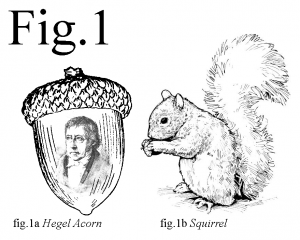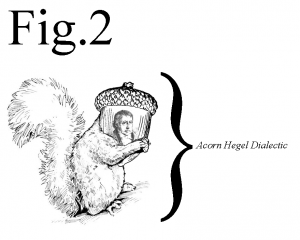What might be a “tutorial,” but technically is not.
Animations can be made very quickly with Photoshop® and ImageMagick. On subsequent pages I do this by converting the layered psd file to a gif. If you have a gluttony for tedium, you could also export each frame individually, the process is only slightly different.
We’ll pretend newer versions of Photoshop which have animation features don’t exist, it’ll be more fun that way.
Category: Uncategorized
Hegelian Dialectics as Interpreted by the Pineal Gland in a Ground Squirrel
At the current moment there is a ground squirrel in the park contemplating what it considers to be a dire issue. The squirrel moves from place to place at a rapid pace, but now it pauses, as time passes it is clear this not an ordinary sort of sudden logical consternation. No, this is a tidal cascade of analysis welling up from the squirrel’s deep existential reservoir (as squirrels are known to have).
To put it bluntly, the acorn it has perched in front of is peculiar. Upon its rounded surface there is, what appears to be, a kind of engraving of the 19th-century philosopher Georg Wilhelm Friedrich Hegel–of dialectic fame. What’s more, this particular squirrel finds itself in a kind of stupor; it has been awake and about for far longer than the standard 12 hour period of squirrel activity. This is of course assuming that squirrels have a standard 12 hour period of activity.
The squirrel’s mind is in a state of particular Hegelian Readiness–not to be confused with Himalayan Redness (tea, salt, rice, etc.). Melatonin has begun to do its job as a regulatory hormone, and the squirrel is willing to put up with the acorn’s condescension. There is much publicized regarding squirrels in this state. As such, there is ample evidence to assume the squirrel will undergo a marked transformation upon consuming the knowledge this acorn offers.
It is unclear how, but the squirrel, despite being a squirrel, was able to surmise quite a bit about the nature of things from this unlikely situation. It learned much, grew as a being, understood more, and reconciled the opposing forces.
The squirrel has ascended.
House Opening Sequence
Rewatching House for the first time since it initially aired, I’ve noticed details which had not occurred to me before, some more obvious than others. I get different things out of it than I did 10, and certainly 14 years ago. I like it when the creators of such things have an attention to detail, but the immediate topic is simply the placement of names in the opening credit sequence.
House uses a cold open (the title sequence begins after an opening scene, usually of how the patient-of-the-week collapses, experiences something clinically strange, or otherwise how/why they wind up at Princeton Plainsboro). The title sequence itself is relatively short, around 30 seconds; but is stylish. Actor credits are displayed against a sequence of (mostly) anatomical images (brain, chest x-ray, etc.), the outlier being an aerial shot of a river.
Immediately obvious is the connection between ‘top-billing’–Hugh Laurie, who plays Gregory House–and the image of a cranium/brain. This forms the basis of postulating a relation between the image shown and characteristics possessed by each actor’s character. A quick analysis is given below.
- Hugh Laurie (House)
- Image: Brain
- House is smart. Yes, this one is obvious and boring to mention; but it stands to reason that a defining character trait of House is his intelligence, making this pairing appropriate.
- Lisa Edelstein (Cuddy)
- Image: Vein? Nervous system?
- Both interpretations of the image relate to her role as an administrator (regulator)–of both the hospital and of House.
- Omar Epps (Foreman)
- Image: Chest (x-ray), rib cage, sternum, heart? lungs?
- Displayed this way, the chest can represent many things; strength, defensiveness, but transparent.
- Robert Sean Leonard (Wilson)
- Image: Brain (middle), corpus callosum
- The corpus callosum allows communication between the hemispheres of the brain; it balances and forms connections.
- Jennifer Morrison (Cameron)
- Image: A river
- An outlier (see below). However, it being an outlier can itself be thought of as representing the occasional social-awkwardness of her character. Not to mention the multitude of symbolic meanings for water/movement.
- Jesse Spencer (Chase)
- Image: Spine
- As per the phrase “grow a spine.” Chase has a ‘spine’ in this sense.
- …and while not a character, the final image is of the text “Created by David Shore” placed above a headless torso. Faceless, not on screen. Is the ‘head’ of the show.
Lastly, it should be mentioned that according to the show’s creators, the opening images do not have a thought-out relevance in-line with what I out-lined above. Happy accidents can be as fun to analyze as anything else (this is not an endorsement of getting bogged down in irrelevant details).



